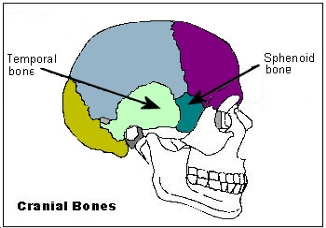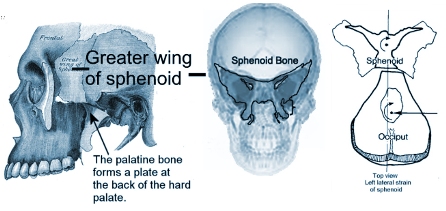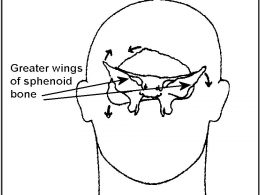Vestibular vertigo and motion sickness are different forms of dizziness but they are related through the craniosacral system. Both involve dysfunction of the regular symmetrical movement of cranial (skull) bones in response to fluid pressure changes in the brain and spinal cord.
Vestibular vertigo usually involves a sense of spinning or other motion either of the body or the surroundings when no motion is physically present. This type of vertigo involves the balance organs within the inner ear. Vertigo results when the temporal bones, the bones on the side of our heads to which our ear are attached, are moving microscopically in opposing directions.
Motion sickness, on the other hand, relates more to a mismatch between what our eyes are telling us about our position in space and what are ears are telling us.
Motion Sickness
 Motion sickness is caused by improper movement or misalignment of cranial bones, but in this case the bone in question is the sphenoid. The sphenoid is a butterfly or bat shaped bone that crosses the head behind our eyes. The greater wings of the sphenoid can be felt under the soft tissue at the temples.
Motion sickness is caused by improper movement or misalignment of cranial bones, but in this case the bone in question is the sphenoid. The sphenoid is a butterfly or bat shaped bone that crosses the head behind our eyes. The greater wings of the sphenoid can be felt under the soft tissue at the temples.
Dizziness, fatigue, sweating, headache and nausea are the most common symptoms of motion sickness. Vomiting may also occur.
Causes of Motion Sickness
Motion sickness is thought to be caused by a contradiction between what the eyes perceive as balance and what the balance organs in the ears perceive. When the head rotates or tilts in any direction, the eyes move in the opposite direction to compensate, maintaining a stable visual image. This relationship between the eyes and ears is called the vestibular-ocular response or VOR. If information from the eyes and ears contradict each other motion sickness results. For example, the eyes may see the environment as stable in the cabin of a ship while the ears perceive the rocking of the boat.

One popular theory about the cause of motion sickness according Wikipedia is that a discordance between the eyes and ears causes the brain to conclude that the individual is hallucinating and further that the hallucination is due to poison ingestion. The brain responds by inducing vomiting to clear the supposed toxin.
Another hypothesis seems a lot more reasonable in light of craniosacral therapy. According to the nystagmus theory, interference with the VOR may occur when a contracted eye muscle is stretched causing direct stimulation of the vagus nerve which causes nausea.
 The sphenoid forms a part of the eye socket. The optic nerve and the motor nerves to the eyes pass through the sphenoid. When the sphenoid is compressed, twisted, or pushed to one side it can theoretically cause misalignment of the eyes causing a problem with focus between the two eyes. It is conceivable that contracted eye muscles, as in the nystagmus theory, may be stretched either directly by displacement of the sphenoid or by membrane tension on the bone and muscles. This seems like a much more simple and direct explanation of motion sickness than the the hallucination theory.
The sphenoid forms a part of the eye socket. The optic nerve and the motor nerves to the eyes pass through the sphenoid. When the sphenoid is compressed, twisted, or pushed to one side it can theoretically cause misalignment of the eyes causing a problem with focus between the two eyes. It is conceivable that contracted eye muscles, as in the nystagmus theory, may be stretched either directly by displacement of the sphenoid or by membrane tension on the bone and muscles. This seems like a much more simple and direct explanation of motion sickness than the the hallucination theory.
Treatment of Motion Sickness
Common medicines for motion sickness include Scopolamine, Dramamine, meclazine and Benadryl, but none of these is a cure, and they must be taken before any activity which may cause motion sickness to dampen the symptoms, particularly nausea.
Adjusting a misaligned sphenoid has resulted in the complete elimination of motion sickness in a number of individuals I have seen in my practice, including people who have had it for decades with no relief from medicine.